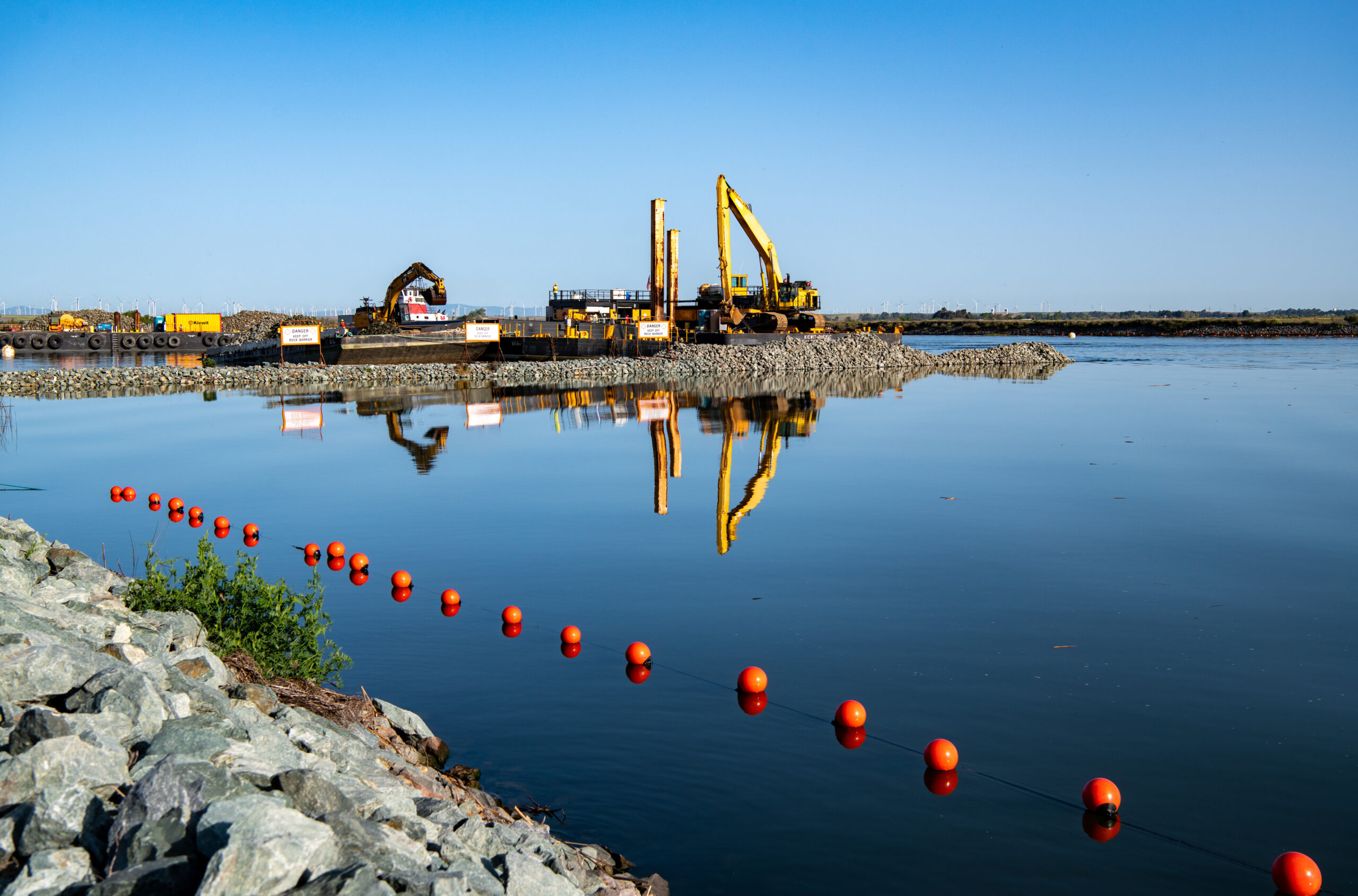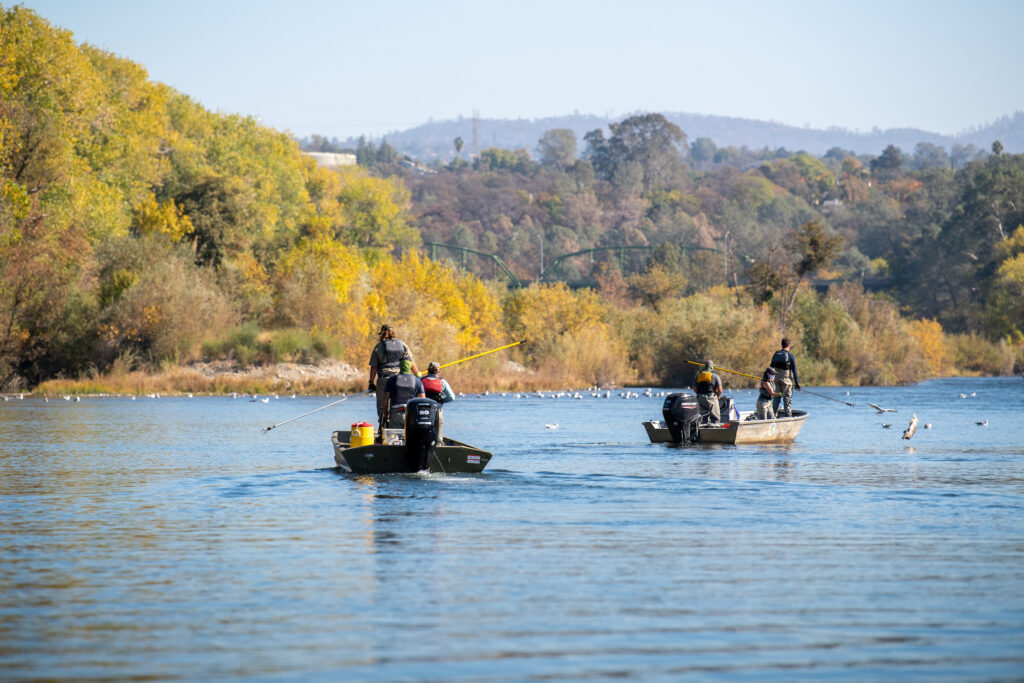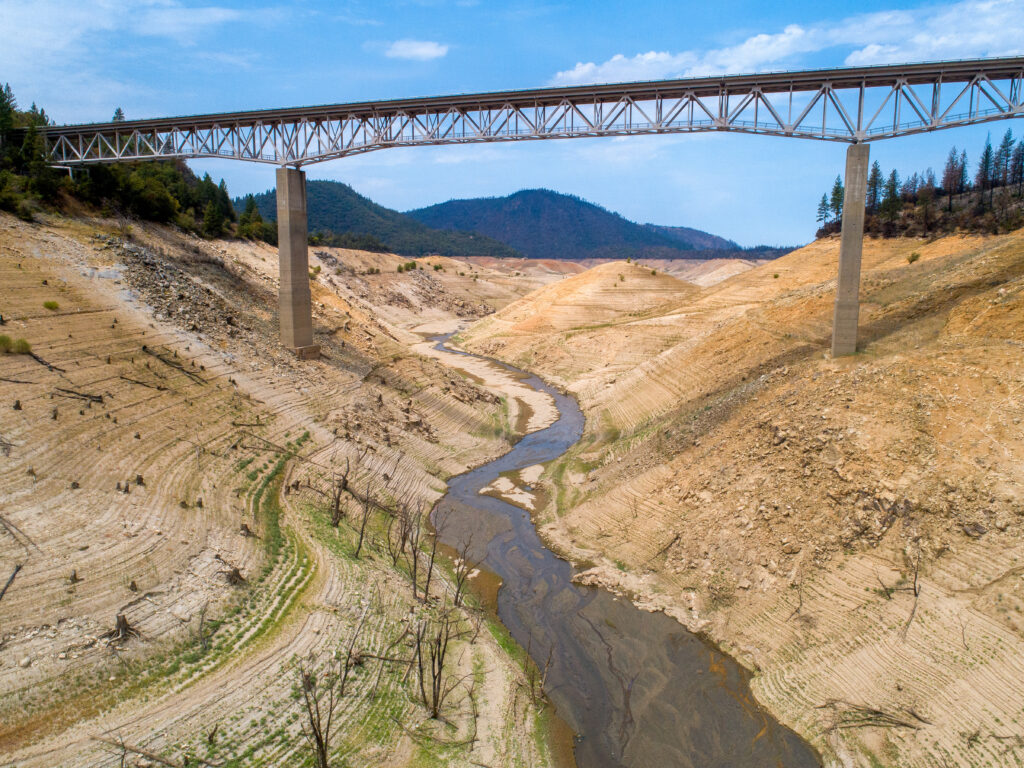
Promising up to 825,000 acre-feet a year of new water to protect endangered fish and thousands of acres of habitat improvements, the Newsom administration and others hailed the March announcement of a proposed voluntary agreement on Bay-Delta flows as the beginning of the end of California’s water wars, and a boon to the Bay-Delta ecosystem.
“We think this has the promise to give us more benefit for ecosystems because we would be combining both flow and habitat assets,” says California Natural Resources Agency spokesperson Lisa Lien-Mager. And by providing an alternative to government mandates already in the works, proponents say the deal will head off litigation that could delay guaranteed environmental flows for years.
Following a decade of stop-and-start negotiations, in March the Resources Agency signed a memorandum of understanding outlining the agreement together with three other state agencies, the U.S. Bureau of Reclamation and 11 water agencies — almost all of them state or federal water contractors, including Metropolitan Water District (Met) of Southern California and Westlands Water District.
The Newsom administration will propose the voluntary agreement (VA) to the State Water Resources Control Board as means of implementing the Board’s update to the Water Quality Plan for the Bay and Delta. The new agreement would, in effect, be an alternative to the Board’s 2018 framework for Sacramento River Basin flows. That framework, which would require 45% to 65% of unimpaired flows into and through the Delta to San Francisco Bay, was never formally adopted, and has been on hold during the VA negotiations.
The eight-year, $2.6 billion program established by the agreement would implement the Board’s water-quality plan “in a way that doesn’t result in a long, protracted water rights process,” says Met’s Bay-Delta policy manager Steve Arakawa. “The idea is the environment will see [benefits] much quicker.”
Bay-Delta environmental advocates are skeptical at best. The proposal is light on details, and includes a lot of red flags, they say, starting with that 825,000 acre-feet of new flows. When you dig into the numbers, says San Francisco Baykeeper senior scientist Jon Rosenfield, it turns out that in both wet years and critically dry years — which account for 47% of years — the agreement only claims to provide around 150,000 acre-feet for fish. “I get going with your top line,” he says, “but in almost half of the years, it’s not going to be anywhere close to that top line.”
Describing the water as “new” or “additional flows” for the environment is also problematic, argue Rosenfield and others. Previously, specific flows have been committed to beleaguered species by various standards, decisions, and opinions. The March voluntary agreement uses water required under the Water Board’s late 1990s Decision 1641 (which set the “X2” estuarine habitat health standard) and the biological opinions issued in 2019 under the Trump administration as a baseline.

Those Biological Opinions, or BiOps, which dramatically increased the amount of water that could be exported relative to the previous BiOps, are widely viewed as deeply flawed. Arguing that they are inadequate to protect endangered salmon and other species from extinction, California sued the federal government to invalidate the 2019 BiOps, and the Biden Administration has declined to defend them in court. Last year the Bureau of Reclamation reinitiated consultation on water project operations, launching a process that will lead to new BiOps by 2024. In the meantime, as drought and exports continue to squeeze flows, populations of endangered salmon and smelt will likely decline precipitously.
“Why [is the state] using the Trump baseline when they disagree with it?” asks Rosenfield. “This is a case where you lower the floor to make your table look higher. The water promised in the VA is basically filling a hole that was created when the Trump administration lowered the floor compared to the 2008-2009 Biological Opinions.”
According to Doug Obegi , a senior attorney with the Natural Resources Defense Council, “Once you account for the changed baseline and the different water-year types, the VA proposes around 300,000 acre-feet of water per year for the environment compared to the
“In critically dry years,” says Rosenfield, “the new VA proposal would provide less flow for the environment than it received under previous regulations that everyone agrees were inadequate.”
Lien-Mager notes that the voluntary agreement includes the 2019 BiOps because they “refer to the current regulatory framework for the Central Valley and state water projects and solely for the purposes of measuring whether the flows and habitat are additive to the system.” The agreement acknowledges that the BiOps may be modified, she says, adding that any discrepancies between water commitments in the VA and future requirements under a new BiOp would be reconciled prior to completion of the State Board’s regulatory process.
Although the March agreement is billed as an eight-year program that will be monitored and adaptively managed to ensure that environmental goals are met, “the state plans to use this agreement as their proposal for flows the planned Delta tunnel must meet,” says Obegi.
Emails obtained through a Public Records Act request indicate that “when the Department of Water Resources submits their water rights petition for the Delta tunnel to the State Board, they’re not going to analyze a wide range of outflows, they’ll just propose what’s in the VA,” says Obegi. If the petition is approved, the flow requirements in the agreement would effectively become permanent, unless the rules were changed in the future.
Whatever the exact amount of environmental water that’s provided by the VA really is, it’s clearly inadequate, say Bay-Delta environmental advocates. They cite the State Board’s 2018 framework and its 2010 flow criteria report to the California legislature, as well as numerous studies by state and federal fish and wildlife agencies, NGOs and academics, that found that a much greater amount of flow, released on a more natural pattern, is needed to restore the estuarine ecosystem.
The proposal for a voluntary agreement between agencies and water contractors on flows into and through the Delta requires understanding some terminology, specifically the concept of “unimpaired flows.” READ MORE
It’s also unclear where the water for the voluntary agreement will come from. According to the agreement’s term sheet, about one quarter of the water will come from the San Joaquin River Basin (most of the rest will come from the Sacramento River and its tributaries, and water purchases). However, none of the San Joaquin River water districts have signed onto the voluntary agreements.
“Why are they counting new contributions to tributary flow from water districts that have not signed on to the VAs?” wonders Rosenfield.
Lien-Mager hopes “the water agencies on the San Joaquin tributaries can and will become part of the VA at some point.”. She adds that if the State Water Board approves the agreement, “the intent is to have a dual path — the VA implementation path for those who sign on, and the regulatory path for non-VA parties.”
The San Joaquin Basin is covered under Phase One of the water quality plan update, which the State Board formally adopted in 2018, and which requires that 40% of unimpaired flow stays in the rivers from February to June. The proposed VA provides less than 30% of unimpaired flow from the San Joaquin’s tributaries, says Obegi, noting that the State Water Board, the California Department of Fish and Wildlife, and the U.S. EPA all rejected 35% as inadequate in 2013 when that figure was proposed as part of a prior VA.
Several San Joaquin Basin water agencies, the Modesto and Turlock irrigation districts, and the San Francisco Public Utilities Commission have proposed their own Tuolumne River Voluntary Agreement.
“Although we were not asked to participate in the development nor the signing of the state’s memorandum of understanding, Modesto and Turlock irrigation districts are committed to a collaborative solution,” says Modesto Irrigation District spokesperson Melissa Williams. “We still believe that a voluntary agreement is the best resolution that will provide water and habitat improvement for fish, while ensuring water supply certainty for our region.”

A key selling point for the VA is that it would provide for about 45,000 acres of habitat restoration to benefit Delta species. This would be on top of the 25,000 to 30,000 acres of restoration already required as mitigation for the state and federal water projects, says California Department of Fish and Wildlife director Chuck Bonham, who calls the water commitments in the VA “not insignificant.” He believes that focusing too closely on flows is a mistake.
“The debate often devolves into ‘Is it more freshwater flows [that are most important to species protection] or is it habitat?’ I actually think it’s both,” says Bonham. “There’s an equation between cold, clean water in sufficient volumes and the abundance of aquatic species. But abundance alone isn’t a long-term fix. When you restore habitat, you’re creating resiliency. They have more space and places to live and thrive. If we don’t do more good restoration projects, faster, we’re missing an equally important part of the problem, and the solution for it.”
Most of the funding for the VA would come from a combination of state and federal funds, with less than 25% coming from a self-assessment paid by the water agencies. Exporters from the state and federal projects would impose a $10 per acre foot charge for deliveries, says the Metropolitan Water District’s Arakawa. Besides habitat restoration, the bulk of the money would go to water purchases, which provide a significant portion of flows under the proposal.
“It raises the question of why is the public paying for water that it owns?” says Rosenfield. “The citizens of California already own the water.”
“The idea here is a comprehensive way of managing the system, because the system has been affected by more than just the water projects,” says Arakawa, pointing to the effects of climate change. “So it’s a combination of things that we need to manage for both supply reliability and environmental protection. It’s bringing those resources together to implement a comprehensive approach that goes beyond just setting flow requirements.”
Hovering over all the questions about what is in the VA are concerns about who negotiated it. When talks began back in 2012, participants included a range of stakeholders, including environmental groups, fishermen, tribes, and Delta communities. But for the last several years, those stakeholders have been excluded from talks, and none participated in the development of the new VA.
“This was a deliberate attempt by the administration to exclude all of the other relevant interests in their discussions,’ says Gary Bobker, director of the Bay Institute.
The California Natural Resource Agency’s Lien-Mager says the public’s opportunity to weigh in is still to come. “Once this is translated into a legally binding document the State Water Board will need to analyze and do their whole public process. There are still many steps and a lot of process that will happen.”
On April 29, the Department of Water Resources invited several past participants in voluntary agreement negotiations to two governance and implementation workshops for the VA, the first of which was scheduled for early May. The invitation was not received warmly.
“Asking our organization to participate with three-day notice for the first meeting in a process that is near completion is not an offer rooted in equity,” wrote Restore the Delta director Barbara Barrigan-Parrilla, who declined the invitation. “Such a late request, after the bulk of the planning has been completed, diminishes the broader environmental justice and tribal community to a checkbox in order to say such outreach has been completed.”
Some say the entire premise of the voluntary agreement — that it will avoid litigation and deliver environmental benefits more quickly than if the State Water Board just adopted and implemented the existing water quality plan update — is flawed.
“Of course it will be litigated,” says Bobker. “We’re talking about water and endangered species in California.”
Top Photo: Low freshwater flows necessitate construction of a rock barrier on False River this April, to prevent salt water intrusion into the Delta. Photo: Florence Low, DWR
Related Estuary News Stories